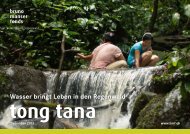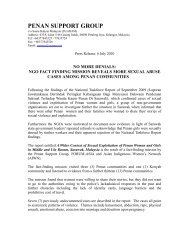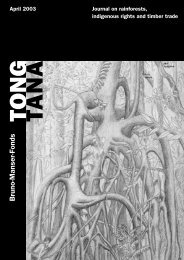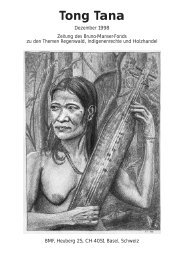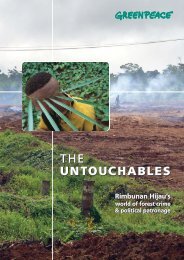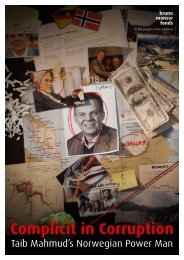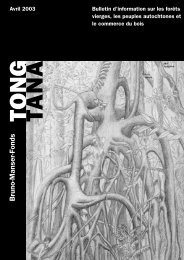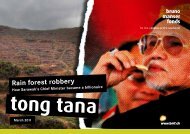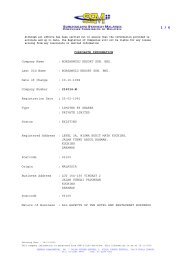Tong Tana December 1999 - Bruno Manser Fonds
Tong Tana December 1999 - Bruno Manser Fonds
Tong Tana December 1999 - Bruno Manser Fonds
Create successful ePaper yourself
Turn your PDF publications into a flip-book with our unique Google optimized e-Paper software.
Arson in Sarawak I<br />
jk – The forest fires in Borneo were fortunately not a<br />
topic this year. It was actually good luck that there was<br />
no continuation of the conflagrations but the forest did<br />
burn like it did in the past two years, only the rainy season<br />
began on time and quenched the fires that were<br />
set on purpose before a blanket of smoke could cover<br />
SE Asia. The plantation industry continues to use the<br />
illegal slash-and-burn methods to claim land, as the<br />
highest authorities for the environment in Malaysia stated<br />
in August: with the help of satellite pictures 11 companies<br />
in the plantation business could be arrested.<br />
The guilty also included the notorious Samling Company<br />
and the Shin Yang Company. Both originated in the logging<br />
industry and are now diversifying in the palm oil<br />
business. As the interconnection of the government and<br />
the economy were only exposed by chance, it is not surprising<br />
that Malaysia also did not publish its air pollution<br />
data this summer (reason: tourists should not be<br />
deterred) and also that no legal proceedings have yet<br />
been initiated against the 11 companies. Compared to<br />
the method of preparing the ground without using fire<br />
(US$ 200/ha), burning the forest is so cheap (US$<br />
0.0004/ha) that the next catastrophe is pre-programmed.<br />
Source: Rengah Sarawak, August 25,<strong>1999</strong><br />
9<br />
Timber industry in Sarawak –<br />
who’s making a profit<br />
jk – As the Sarawak Forest Department reported at the<br />
beginning of October, 70% of the approx. 120,000 jobs<br />
in Sarawak’s timber industry are held by foreigners.<br />
According to the Sarawak Timber Association STA they<br />
prefer foreigners because they work more reliable and<br />
cheaper than their own people. Further investigations<br />
would be necessary in order to find out why the relationship<br />
of the indigenous people and the logging industry<br />
was so poor, the STA also stated. The BMF will<br />
gladly make its archives available if those who are<br />
responsible really want to find out why nobody saws off<br />
the branch they are sitting on!<br />
Correction: Forestry in Sarawak<br />
jk – Two mistakes occurred in our report of the talk<br />
with Prof. Dr. Brünig in the last newsletter of September<br />
<strong>1999</strong>. “The elusive issues of social justice and<br />
customary or statutory rights of land and resource<br />
ownership remained outside the concern of Samling<br />
Co.. The co-operation with GTZ effected little change.”<br />
was a remark made by our editors and should have<br />
been marked as such! We apologize to Prof. Brünig for<br />
this omission; unfortunately nothing has changed in<br />
the meantime as to the truth of the statement.<br />
Furthermore the photo that was shown does not depict<br />
the Alan-peat bog forest but a mixed forest of peat bog-<br />
Ramin, with a giant Ramin in the center. The Alan-peat<br />
bog forest is shown here instead (Ed. <strong>Tong</strong> <strong>Tana</strong>).<br />
Alan-peat bog forest: if the canopy would be left intact, e.g. by<br />
application of strip-shelterwoodsystem, sustainable forestry would<br />
be possible using careful cutting and transportation/extraction<br />
techniques, thinks Prof. Brünig.<br />
Malaysian forestry experts<br />
in Cameroon<br />
bm – After the Malaysian Company WTK turned the<br />
lands of several Penan tribes into a battlefield they<br />
now export their expertise in “exploitation” to Africa –<br />
for want of resources in their own country. During a<br />
control tour through a WTK concession area in Djoum<br />
in Cameroon 388 abandoned tree trunks with a total<br />
volume of 1703 m 3 were found: they were either<br />
illegally felled or of unsatisfactory quality.<br />
Source: Bubinga, October <strong>1999</strong>.



